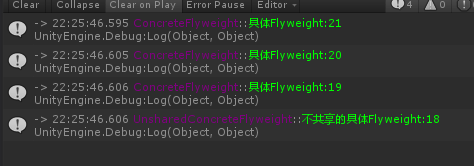2.5.1 模式意图:
在系统中会有一些反复使用的元素,这些元素一般使用周期较短,但使用频率高,为了达到提高复用性和节省内存的目的,则可以使用享元模式。

2.5.2 模式概念:
它属于结构型模式,运用共享技术有效地支持大量细粒度的对象。类似于游戏开发中的对象池。
2.5.3 模式元素:
- 享元类抽象(Flyweight)
- 享元类细节(ConcreteFlyweight)
- 非共享享元类细节(UnsharedConcreteFlyweight)
- 享元工厂类(FlyweightFactory)
2.5.4 代码示例:
using System.Collections;
using System.Collections.Generic;
using UnityEngine;
using Custom.Log;
public class FlyweightFactory
{
private Hashtable flyweights = new Hashtable();
public FlyweightFactory()
{
flyweights.Add("X", new ConcreteFlyweight());
flyweights.Add("Y", new ConcreteFlyweight());
flyweights.Add("Z", new ConcreteFlyweight());
}
public Flyweight GetFlyweight(string key)
{
return ((Flyweight)flyweights[key]);
}
}
public abstract class Flyweight
{
public abstract void Operation(int extrinsicstate);
}
public class ConcreteFlyweight : Flyweight
{
public override void Operation(int extrinsicstate)
{
this.Log("具体Flyweight:" + extrinsicstate);
}
}
public class UnsharedConcreteFlyweight : Flyweight
{
public override void Operation(int extrinsicstate)
{
this.Log("不共享的具体Flyweight:" + extrinsicstate);
}
}示例调用
using System.Collections;
using System.Collections.Generic;
using UnityEngine;
public class FlyweightComponent : MonoBehaviour
{
public void Start()
{
int extrinsicState = 22;
FlyweightFactory f = new FlyweightFactory();
Flyweight fx = f.GetFlyweight("X");
fx.Operation(--extrinsicState);
Flyweight fy = f.GetFlyweight("Y");
fy.Operation(--extrinsicState);
Flyweight fz = f.GetFlyweight("Z");
fz.Operation(--extrinsicState);
UnsharedConcreteFlyweight uf = new UnsharedConcreteFlyweight();
uf.Operation(--extrinsicState);
}
}
2.5.5 写法对比:
略
2.5.6 模式分析:
此模式是通过共享技术,来提高相同或相似对象的利用率,有效减少因频繁实例或销毁造成的性能开销,并且减少内存压力。
- 优点:大大减少对象的创建,降低系统内存占用,对象使用率提高。
缺点:提高了系统的复杂度,需要分离出外部状态(根据上下文传入的参数)和内部状态(通用部分),而且外部状态相对独立,不应该随着内部状态的变化而变化,否则会造成系统的混乱。
【额外说明】:
对于HashMap中所持有的享元元素,为了更精确的控制还要注意控制其元素的生命周期,以规定检查的方式清除不必要的元素,进一步缓解内存压力。
如何检查:主动触发式检查、 被动触发检查、系统定期检查。
按何权重清理:元素的剩余时间、元素使用次数、自定义权重算法。
2.5.7 应用场景:
如果遇到下面这些情况,可以考略使用享元模式
- 系统中有大量对象或对象较消耗内存
- 系统不依赖于这些对象的身份(例如唯一标识),这些对象是不可分辨的。
2.5.8 小结:
对于使用享元模式带来性能提高的同时,也要关注其对系统复杂性的影响。在性能的提高和共享粒度控制之间寻找有效的平衡点。